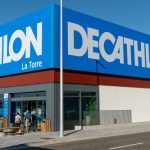After a rather tepid presentation of some arguably outstanding results on their earnings conference call on Monday (SEW_0526), Nike management on Tuesday took some of their biggest investors and some influential analysts through their detailed plans for the future. For those that see their businesses ebb and flow in the wake of this massive ship — which touches just about everyone these days — the output of the conference should give the industry a very valuable peek inside the Emerald City and some insight on its new wizard.
Newly anointed Nike Inc. president and CEO Bill Perez kicked off the meeting by laying out a key difference from the world he had just come from when he was president and CEO of S.C. Johnson.
“You have to realize where I came from. I came from a world where my excitement was based on killing bugs and cleaning windows,” said Perez in his opening remarks. “And now I'm in a world where world-class product performance, world-class athletes come together on and off the fields.” He said the company has “great sales momentum” and that the profit profile is “good and improving.”
Perez did say there were “quite a few surprises,” alluding to the energy and enthusiasm within the company as well as the drive to compete to win. But he also said that with any great company, they require a good deal of work on management depth and our skill sets. “This may not be a factor that is immediately quantifiable, but it's arguably one of the most important tasks at hand,” said Perez. He did emphasize that they are not short on management help today, but they need to plan for the future.
One of the key tasks at hand for Perez and Nike, Inc. will be converting the company from Swoosh disciples to global multi-brand marketers, an area that is seen as one of the main reasons he was brought on board.
Scott Olivet, VP of NKE subsidiaries and new business, outlined the rationale behind the multi-brand strategy. “While the Nike brand has tremendous stretch, you can only push it so far,” said Olivet. “If you try and communicate too many things to too many people, your message eventually gets muddled. If you tell the consumer you're good at everything, you lose credibility.”
“We are systematically building a group of brands to hit the intersection of three circles: targeted market and consumer segments, brands that have strong positioning and that fit within our portfolio, and third, where we can leverage Nike, Inc. We're looking for segments where we believe we should play, that have the right long-term dynamics and where we think the opportunity is best addressed with the brand complementary to the Nike brand.”
But Olivet also hinted that the company isnt so much focused on acquisitions as they are on maximizing and realizing the potential of the current brand stable.
“We're looking at increasing the size of our effective markets or increasing the number of offenses against a particular market. New consumers, new occasions, new channels are all possibilities for growth. Multi-branding is the strategy; acquisitions are only a method.”
Olivet said the strategy for achieving leverage in the portfolio is to “utilize all of the knowledge and experience across all of Nike, Inc.” to share services wherever possible. “Nike makes significant investments in technology, in design capability and supply chain,” said Olivet. “If we can leverage these investments across the portfolio, that will help drive the gross margin and SG&A leverage.”
He did acknowledge that these synergies need to be realized while giving each unit autonomy so that they can “meet their individual consumer needs and compete on their own terms.” He used the relationship between brand Nike, Starter, and Converse as an example.
“Converse and Starter enable us to get after a different segment of the worldwide athletic footwear and apparel market, Converse competing more directly in the white style and more moderate zone and Starter enabling us to get after the value channel. Converse is a strong complement to the Nike brand. While there's some overlap with Nike, Converse has a very different brand proposition, plays more squarely in the lifestyle zone and plays at more moderate price points. Our growth opportunities are largely focused in the lifestyle zone but it is still important to continue to authenticate the brand and performance. We're also optimistic about our growth opportunities in apparel.”
NKE laid out their footwear brand placement strategy in a slide similar to the following graphic:
In regard to the Starter brand, Olivet said it “will be positioned as performance and premium within the value segment,” based on the perspective that the “value channel consumer is evolving from somebody who is only looking for the best possible price.” NKE believes that that consumer does believe in aspirational brands and that they will “pay more for the right product, value and brand combination.”
As for synergies within Nike Inc., Olivet noted that they have also increased the level of resources for dedicated projects working cross-brand. He said it has enabled them to drive not only cost reductions but also some “significant revenue opportunities.”
“Converse, in its first year alone, was able to drop $5 million to pre-tax income on simple cost-saving things alone,” said Olivet. “Converse just launched Converse 1, the customization site. The only way that this was possible is because we were able to take the experience of the Nike ID team and we were able to leverage an existing IT platform.”
In fiscal 2005, revenue from the Nike “other brands” increased 22%, from just over $1.4 billion to $1.74 billion, but the number doesnt include the wholesale value of Converse International, which is primarily licensed, and Exeter, which has a royalty fee model. The actual wholesale revenue from Exeter and Converse international was $740 million in 2005, up from $263 million, presumably with most of the nearly $500 million increase coming from newly acquired Exeter. SEW would assume that NKE will continue to bring the Converse distributors in-house as those deals expire.
Don Blair, Nike, Inc. VP and CFO, explained that operating metrics improvement over the last four years was driven primarily by revenue and gross profit margin expansion. He also pointed to strong cash flow that has reduced net interest expense and allowed NKE to repurchase shares, creating earnings per share growth.
Blair noted that “the international business for Converse as well as the Starter business has a very high gross margin percentage. Essentially, revenue is almost 100% flow-through to gross margin. So as those businesses grow, we expect to see improvement in the gross margin percentage.”
The CFO explained the drivers of the change in U.S. Footwear gross margins from fiscal 2001, when Nike implemented their new supply chain systems, to fiscal 2005. Over this period of time, Nike increased gross margin by 440 basis points. Gross product margin improved 290 basis points. Closeout margin improved 150 BPS, attributed to the growth of their factory outlet system worldwide. Air Freight dropped 30 basis points, while “changes in account mix” and perhaps due in part to the growth of the larger higher-discount-earning retailers like Foot Locker and The Finish Line having a negative effect on margin of 60 BPS.
Eric Sprunk, VP and GM of global footwear explained described three initiatives that helped improve margin: Materials management, lean manufacturing and supply chain improvements.
Material management entails seeking out and leveraging materials across product categories rather than each area sourcing their own materials. With fully two-thirds of the cost of a shoe coming from materials, this has clearly had a material impact on margin.
Lean manufacturing is simply “four fundamental principles — eliminate waste, reduce inventory, increase speed and improve quality.”
The supply chain initiative has impacted 5 metrics of cost saving: 1) lead-times reduced from nine months to six months. 2) Pre-build percentage from 30% to less than five. 3) On-time delivery has increased from 82-88% to 92-95% 4) reduction in air freight (14 times more expensive than ocean) from 5% to 3%. 5) Inbound visibility increased from zero weeks to four weeks, allowing orders to be re-sold and/or redirected.
On acquisitions, Mr. Blair said, “We will, on a case-by-case basis, continue to look at acquisitions but making sure that those are ones that can create value for our shareholders, much the way some of the ones we have done recently will do.”
Perez added that he saw any major gaps in the product portfolio right now, due in large part to the fact they have just filled the biggest gap they had, which was the “quality low-price-point footwear product.” He did hint at some gaps in how vendors and retailers work as partners in this industry.
“I think perhaps an opportunity we have would be to engage with our retail partners on a quantitative basis more than we have done in the past, where we try to maximize consumption in their stores through the analysis of data, category management type activity, which is very common in the food and mass channels of trade, but not so common in our channels of trade,” said Perez.
Perez ended the meeting with these thoughts on opportunities to build the organization: “I think there are a number of areas where I think we have opportunity. One is to give people general management opportunities early in their career. We have got to give people that developmental opportunity earlier in their careers. Secondly, as we have expanded around the world, we have stretched our marketing talent. We have moved them around a lot. We have to invest more in that area, grow some more talent. And then the third area is what I would describe as the quantitative component of sales function. We have to arm our people with more quantitative skills, because this business will become an analytical one, as opposed to simply a relationship one.”















